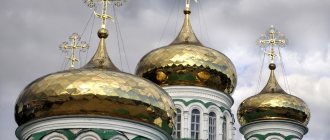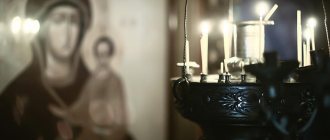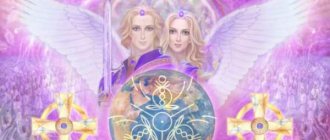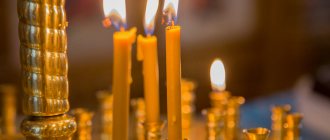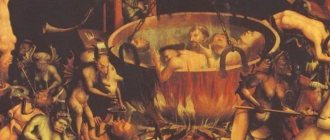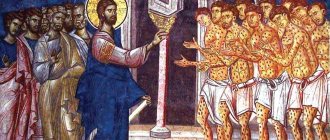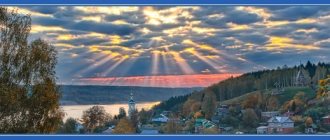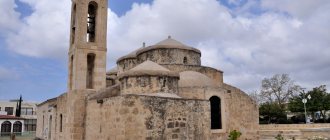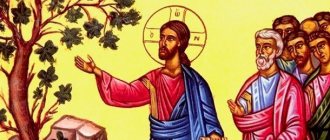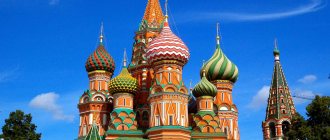Tens of thousands of Orthodox believers and curious tourists flock to the Christian capital of the world every year on Holy Saturday. They walk, travel by bus, fly on charters in order to personally be present in the Church of the Holy Sepulcher at the descent of the Holy Fire. And in the first moments after his appearance, wash yourself with the miracle-working Jerusalem flame.
An ancient phenomenon that has existed for two millennia. The descent of the Holy Fire takes place in front of millions, but at the same time it still keeps the secret of its appearance - what is it: a miracle or a symbol of faith?
What is the Holy Fire
Translated from Greek it means Holy Light. That's what they call it in Jerusalem.
On Holy Saturday, the Greek patriarch and the Armenian archimandrite behind the closed doors of the Edicule (Royal Tomb) mysteriously receive the Jerusalem Fire from the Lord. And then all those present light all the candles and lamps from it in the temple and outside it.
Origin of the expression and interpretation
Judging by written sources, the first witness to the appearance of Fire was the Apostle Peter. Having learned about the resurrection of Christ, he hurried to the tomb and discovered that the body of Jesus was not there. And the cave itself is illuminated with a miraculous radiance. This was the time when the Fire descended for the first time.
Since then, the Easter fire has become a symbol of the True Light. His birth symbolizes the Resurrection and immortality of the Son of God.
Litany of the Holy Light
Every year, on Holy Saturday, the entire Christian world waits with bated breath for the miracle of the appearance of the Holy Fire. The temple ceremony or litany of the Holy Light begins on Saturday morning. Pilgrims, and among Orthodox Christians there are atheists, Muslims, believers of other faiths, line up from early morning.
In the Temple of the Lord, all candles are extinguished, this is strictly monitored by representatives of different churches. After verification, the Edicule is sealed with a large seal by the keeper of the keys, who is a Muslim.
There are three groups of people whose presence is mandatory in the process of preparing for the descent of the Holy Fire. The Lord chose the Patriarch of the Orthodox Church of Jerusalem to attend the sacrament of the appearance of the Holy Fire.
Important! Only a representative of the Orthodox Church can receive the Holy Light, and this is not the choice of Orthodoxy itself. This is God's choice.
Representatives of the Armenian Church in 1579, by agreement with the mayor, entered the temple, leaving the Orthodox priesthood outside the doors of the temple. The Armenian representatives prayed for a long time, but the Light did not descend. Orthodox priests also remained in reverent prayer. Suddenly, strong thunder sounded in the Temple, the column standing to the left of the door of the entrance to the Edicule cracked, and a Fire appeared from there, lighting the candles of the Orthodox Patriarch.
Traces of this miracle can be seen to this day.
Traces of the Holy Fire in the Church of the Holy Sepulcher
From that time on, there was no one willing to challenge the right of the Orthodox Church to receive the Holy Fire. Representatives of various Christian denominations can be present at the appearance of the Grace of God - the descent of God's Fire. They receive the Holy Light from candles lit by the Orthodox Patriarch of Jerusalem.
The second group of people, without whose presence the miracle of the descent of Light does not occur, is monasticism, representing the Lavra of St. Savva the Sanctified. This tradition dates back to 614, when 14,000 monks died at the hands of the Persian conquerors. Currently, 14 monks constantly serve in the monastery.
Many pilgrims are surprised and even outraged by the loud behavior of Arab Christians. The guys sit on top of each other and loudly praise God and dance. The time when this tradition began is unknown, but when Arabs were banned from entering the Temple during English rule, the Fire did not appear until Arab youth were allowed in to perform their rituals.
Arab Christians Praise God
Despite the weather, even on sunny days, from 9 a.m. pilgrims can hear sounds reminiscent of thunder. In some years, around noon, the temple and courtyard begin to be illuminated by heavenly lightning, which are the harbingers of the descent of the Holy Light.
At this time, the prayers of Arab youth sound loudly. Around 13.00, the litany begins, during which the priesthood, led by His Beatitude the Patriarch of Jerusalem, walks around the Edicule three times in a procession of the cross, stopping in front of its entrance.
The Patriarch is stripped down to his vestment, and sometimes a demonstrative search takes place, showing that His Beatitude does not have the means to light a fire.
In great excitement, the Patriarch enters the Edicule, bows his knees and offers a prayer of petition to God, on which depends whether the Lord will have mercy on His people. The air is saturated with hope and anxiety, and when the excitement reaches its peak, frequent glares of heavenly color permeate the air, a bright Holy Light literally bursts out from the Edicule, from 33 candles lit by God himself, handed over by the Patriarch. The fire spreads like fiery streams throughout the Temple and beyond. People are happy, dancing, singing.
His Beatitude Patriarch of Jerusalem
Many pilgrims testify that at this moment they felt real cleansing, like a second birth.
Historical reference
As early as the fifth century, the Jerusalem Church began its services on Holy Saturday only after the Evening Light had appeared.
Since IX, written evidence in history indicates that the miracle of the descent occurs after saying the prayer “Lord have mercy.”
“The lamps located above the Tomb were lit by an angel without outside help,” we read in the writings of the pilgrim Bernard Monk (867).
There is a lot of similar evidence left in sources over the past centuries: in the chronicles one can trace the annual ignition of Fire over many centuries.
And in the modern world, every year on Holy Saturday the entire Orthodox world, praying, awaits this miracle.
Church of the Holy Sepulcher: history and modern style
The territory of the Church of the Holy Sepulcher is represented by a whole complex of architectural buildings, which include:
- Golgotha and the place of the Crucifixion;
- Edicule;
- Katholikon - a cathedral intended for the Jerusalem patriarchs;
- the Temple of the Finding of the Life-Giving Cross, located underground;
- St. Helen's Cathedral;
- monasteries;
- galleries.
God's love united different churches in one territory. The Jerusalem Orthodox Church presides over services at its shrines, Golgotha, Edicule and Katholikon. Order of St. Francis has a Franciscan church and an altar of nails. The Armenian Apostolic Church presides in the Cathedral of St. Helena, the chapel of the “Three Marys”.
The Ethiopian Church conducts services over the grave of St. Joseph and the altar located on the western side of the Edicule. The wall protecting the Temple from the entire city was built by Sultan Suleiman even before Orthodox Christians appeared there. Golgotha - a rock, the place of suffering and the Crucifixion of Jesus, in those ancient times was located outside the city walls.
The Holy Tomb, the cave in which the Savior was buried, is located a few meters from Golgotha. Initially, it had two chambers - the entrance and the burial room itself, in which there was a bed - arcosolium, a place of ritual burial.
In the fourth century, Equal-to-the-Apostles Helena ordered to cover two shrines with vaults of the Basilica, which now bears the name of the Church of the Holy Sepulchre.
Church of the Holy Sepulcher in Jerusalem
The Chapel of Edicule, or translated as the royal bedchamber, “covers” the burial cave of Jesus. Nowhere else in the world is there such a chapel. Edicule is a unique place on earth that preserves the memories of the King of kings, the Lord of lords, who was buried and resurrected in this place.
As in ancient times, there are two chambers in the Edicule, in the first you can see a large bed - arcosolium, the entrance room is known in the modern world as the Angel's Chapel. In the Angel's Chapel there is kept a part of the stone block that the angel rolled away. It was from this stone that the Angel sitting on it addressed the wives who brought peace to the Teacher’s tomb.
Church of the Holy Sepulcher - a modern view of Golgotha
Church of the Holy Sepulcher
It is believed that it stands on the spot where Jesus Christ was crucified and resurrected.
Despite its worldwide fame and its significance in the history of Christianity, it surprises with its miniature size. Under one roof it contains Golgotha (the site of the crucifixion of Christ), and Edicule (a small marble chapel over the cave of the Sepulcher of Jesus), and the cathedral church of Kaphoklion. As well as chapels (small churches) of six churches - Catholic, Armenian, Coptic, Ethiopian, Syrian and Orthodox.
Once outside the temple gates, pilgrims follow the final path of Christ’s ascension to Golgotha.
The church service before the sacrament of the descent of Fire also reproduces the events of Holy Saturday - the passion of Christ, the crucifixion and resurrection:
- At the entrance to the church, a narrow flight of stairs 4.5 meters long leads to the place that was the last on the way to Calvary.
- At the top is the chapel where Roman soldiers stripped the Savior, preparing him for crucifixion.
- Further on, the silver disk is the place where God was nailed to the cross.
- The Stone of Anointing is located at the foot of Calvary, on which the body of Jesus was wrapped in swaddling clothes and incense by His disciples and prepared for burial.
- And the Holy Tomb is the burial place of Christ.
Performing the ritual
The ceremony is performed by the Orthodox Patriarch. The bishop of the Armenian Apostolic Church also takes part, the only one who accompanies the Patriarch to Edicule, as well as representatives of the Coptic and Syrian churches; representatives of the Ethiopian Church do not participate.
At its core, the rite is a divine service of the Orthodox Church, therefore representatives of other faiths first obtain permission from the Orthodox Patriarch to participate, going to the Orthodox altar to express their respect.
Holy Fire Ceremony
The main cathedral of Israel is small and cannot accommodate everyone who wants to see the miracle of the descent. Therefore, pilgrims and believers gather long before the ceremony begins. And latecomers flood both the square in front of the church building and the narrow streets leading to its walls.
Festive services begin on the morning of Holy Saturday. Moreover, they take place in accordance with a strict ritual.
Entrance of the Armenian delegation
At a quarter past nine the doors open and a procession of the Armenian Jerusalem Patriarchate enters the sanctuary.
After prayers at the sacred places, she makes a circuit around the Edicule and moves to the Armenian Chapel of the Church of the Resurrection.
Preparation of the Holy Sepulcher
Meanwhile, preparations are underway for sealing the Edicule. Cotton balls are laid out on the floor in the Tsar's Bedchamber. When the Holy Fire descends in a blue dew of lights onto the walls and floor of the chapel, the high priest will light one of the cotton balls from them and illuminate the lamp.
In the meantime, not a single candle should be lit here: all this is carefully checked by the police and non-believers.
Exactly at 11.00, representatives of different faiths seal the chapel with ribbons and wax seals.
Troublemaker
After another half hour, the solemn atmosphere of the cathedral is disturbed by the shouts and fun of the Arabs. Young people, loudly clapping their hands and sitting on each other's shoulders, shout out a prayer in which they ask to grant a Christian miracle to the Orthodox.
This is the tradition, and no one argues with it now. However, at the beginning of the 20th century, the English governor tried to ban “savage” dances. The Arabs were not allowed into the Temple - and Grace did not descend. The Patriarch of Jerusalem, having stood on his knees in vain for two hours, ordered the youth to be allowed in. After which the sacrament was completed.
This video shows the entry ceremony for Arab youth.
Arrival of the Chief Mediator
At noon the Greek Patriarch enters the church.
At 12.30 the Greek delegation circles the Edicule three times. And then, in front of the police and numerous pilgrims, the Patriarch is unmasked and remains only in a white vestment, stole, belt and armbands.
Dragoman removes the seals and cords from the door of the Holy Sepulcher and lets the Head of the Jerusalem Church inside. The meaning of the action is that he should not bring any matches or a lighter with him to the Tomb - nothing that would help him light the flame himself. Following him, the Armenian bishop rushes into the marble chapel.
Original in English
Introduction
The Holy Fire, the supreme ceremony of the Eastern Churches, takes place at midday on Easter Eve, according to the calendar of Eastern Christendom, in the Church of the Holy Sepulchre. Its origin is uncertain, but that it is derived from the ritual and symbolism in usage by the very early Church is undoubted: the ceremony is first mentioned by Bernard the Wise, writing in the middle of the ninth century, and may have originated when during the time of Charlemagne pilgrimages to the Holy Places were much encouraged and had become very popular.
In essence, the ceremony symbolizes the triumph of the Christian Faith, renewed year by year in commemoration of the first Victory after Calvary. The Patriarch enters the Edicule over the Tomb, in which for this one occasion all lamps are extinguished, and the “Miracle” of the descent of the Fire occurs. The Fire is then distributed to the crowd that throngs the Church, and is carried away far and wide. Before the War, the Fire was borne by devoted hands to the furthest corners of Russia.
The Turkish Government fearing that the fanaticism and excitement of these Easter crowds might result in an outbreak, were accustomed to station a large body of troops in and around the Church.
Conduct of the Ceremony
The ceremony is conducted by the Orthodox Patriarch. There also participate a Bishop of the Armenian Patriarchate, who alone accompanies the Patriarch into the Edicule, and representatives of the Coptic and Jacobite rites, but not of the Abyssinian, take part as well.
The ceremony is, however, essentially the service of the Orthodox Church, and the representatives of the other rites previously obtaining permission from the Orthodox Patriarch to take part, by proceeding to the Orthodox Altar and doing obeisance.
Participants in the Ceremony
Apart from the Patriarch and the Armenian Bishop, the following olorg and laymen take actual part in the service at periods: — A Bishop, Archimandrite, Dragoman, and <…> of both Orthodox and Armenian rites, a lay represent each of these rites , and one Coptic and one Jacobite <…> sentative, either a cleric or a layman. The Copt is frequently — layman who has purchased the privilege of receiving the Holy Fire.
The Moslem Guardian of the Holy Sepulchre exercises his traditional privilege of sealing the door of the Tomb previous to the entry of the Patriarch, and a Franciscan monk is present throughout the ceremony.
Allocation of Space on the Floor of the Rotunda
At this ceremony the Church becomes entirely filled with a seeing excited congregation, and each rite must be confined to its allotted floor space, within which the area may be further divided by towns.
The Orthodox Area is on the side of the Tomb furthest from the entrance, from the front of the Tomb to the middle of the seventh pillar.
The Jacobite Area is from then to a black cross on the right side of column 9, at a distance of about three feet from the center. This boundary is generally the matter of dispute, the Jacobites claiming the boundary should be the center of the column. The question has, however, been definitely decided as above.
These two boundary lines converge on the north-west corner of the Edicule.
The Coptic Area extends from the Jacobite boundary to the center of column 12, on a line drawn to the south-west outside corner of the Edicule.
The Armenian Area completes the circuit to the front of the Tomb, but the spaces in front of the doors between columns 12–15 are Orthodox.
It must be remembered that the days and nights previous to the day of the ceremony the church becomes filled with pilgrims and others, especially Copts, with bedding, etc., who must on the day of the ceremony be rigorously confined within the limits of them respective areas. Disputes are also likely to occur between the Jerusalem and Jaffa contingents in the Orthodox Area.
Accommodation for Visitors
The Orthodox Balcony on the north side of the entrance to the Orthodox Catholicon from the Rotunda is, by courtesy of the Patriarch, accustomed to be put at the disposal of the Government, and will hold ten people, but only five to six chairs.
The Armenian Patriarch is accustomed to put at the disposal of the Government two windows in the southern gallery, holding seven to eight each. Ladies are usually accommodated here, and there is space in each for three chairs. This is approached by a staircase near the Armenian Vestry on the left of the main entrance.
Other guests can be accommodated in the gallery overlooking the Orthodox Choir. Access is obtained through the Calvary Chapel, and there is ample room, if the view is rather interrupted; there is, however, no seating accommodation.
The Orthodox Patriarch also puts at the disposal of the Government, if possible, a small window in the upper range under the Rotunda. This holds six people standing, and is reached from the Orthodox Patriarchate.
The Balcony on the other side of the entrance to the Orthodox Choir from the Rotunda is at the disposal of the Greek Consul-General.
The spaces immediately below these balconies are reserved for guests of the Patriarchates, Orthodox on the north, and Armenian on the south, and should not be filled except with the consent of the Dragoman. Tiers of seats may not be constructed in these spaces, but benches may be placed for the convenience of those present.
Each visitor for whom accommodation is being found by the Deputy <…> missioner's Offices should be provided with a ticket showing the place allotted to <…> arrangements should be made for guides to direct ticket-holders. The tickets for <…> Gallery and window are supplied through the Deputy District Commissioner <…> the Dragoman of the Orthodox Patriarchate.
Order of the Ceremony
Between 8 and 9 am the doors are opened by the Armenians. Arrangements should be made for a passage-way to be kept through the crowd for the Armenian representatives, and the crowd should be kept some distance from the door, to prevent a precipitous crush and overcrowding when the door is opened.
On entering, the Orthodox congregation pass to the right of the Stone of Unction and enter the Rotunda through the Orthodox Catholicon, the other congregations pass to the left and enter the Rotunda direct.
At 10.30 am the Armenian Patriarch arrives in procession, entering the Rotunda by the main entrance. After passing in front of the Sepulchre, he proceeds round the Rotunda once and then enters the Armenian Vestry. The Armenian Patriarch does not take actual part in the service, but is accustomed to occupy the first window in the Armenian Gallery.
At 11 am the door of the Sepulchre is sealed by the Moslem Guardian in the presence of one Archimandrite of the Orthodox and one of the Armenian rites, standing one on each side close to the door. This sealing consists of the closing of the door and the placing of a large piece of wax across the center of the door, which at the same time holds in place a white ribbon, the ends of which pass through the two door handles. These ends are held during the sealing by the two witnesses mentioned above. The Orthodox clergy are always stationed on the north side of the door, the Armenian on the south.
At 12 noon, the Orthodox Patriarch comes down through the Church of St. James, enters the Holy Sepulchre and proceeds through the south door of the Catholicon to the Altar. The representatives of the other rites then do obeisance and obtain permission to take part in the ceremony.
The Holy Lamp is then taken by an Archimandrite to the Edicule, the door of which is unsealed by the Orthodox Dragoman. The door is not sealed again, but the tapes are replaced.
The two Archimandrites holding the ends of the tapes are now relieved by two Bishops, behind these are two Dragomans, and behind these again two Sextons.
About this time, groups of young men enter the Rotunda through the Orthodox Chapel clapping their hands and singing traditional songs. One or two may be borne on the shoulders of their co-religionists. It is just now when the excitement is running high, and the pressure of the throng is very intense, that disputes occur, especially over the line-up from the holes in the Edicule through which the Fire is given.
The District Staff take up a position by the northern seat near the entrance to the Tomb.
Throughout this period, the space between the entrance to the Sepulchre, including the stone seats and the entrance to the Orthodox Chapel, must be kept clear by Police cordons, momentarily opening when required to let processions through.
No individual should be allowed in this space except the officials and clergy concerned. These latter are the two Bishops, Archimandrites, Dragomans, and Sextons, one of each of the Orthodox and of the Armenian rites, as well as a lay representative of each and the Moslem Guardian. The Coptic and Jacobite representatives do not approach until later, but remain adjacent just behind the cordon to the south. The Franciscan takes up a position near the door of the Sepulchre on the north side.
At 12.30 pm, the actual service commences with <…>cession of the Patriarch from the Altar of the Orthodox <…>. The procession is preceded by banners 13 in number <…> representatives of the leading Orthodox families and asc.” <…> have to be given to clear the way through the
throng. The procession circles the Rotunda three times. On arriving in front of the Sepulchre for the third time, the banners and all the clergy, except the Patriarch, and his immediate attendants, and those previously mentioned, return into the Orthodox Chapel.
The Bishop of the Armenian Church, who is to accompany the Patriarch into the Sepulchre, here joins His Beatitude.
The Patriarch now disrobes, and his mitre and vestments are carried by the attendant clergy to the Altar in the Orthodox Chapel. The door is then opened and the Patriarch enters the Tomb, accompanied by the Armenian Bishop.
The Copt and Jacobite now come forward, and take up their position directly in front of the door, ready to enter as soon as it is opened. The other clergy do not enter at this time, and it is necessary to prevent this, and also to ensure that the Syriac and Copt enter and that the Patriarch is able to come out. The door is not to be opened until the Patriarch knocks.
The Holy Fire is then passed out by the Patriarch and the Armenian representative to their congregations by the holes on each side of the Edicule, through the northern (Orthodox) side first. This is heralded with frantic cheering and clapping of hands and ringing of bells. The Orthodox custom is that the first to receive the Fire is a Parish Priest, and after him a selected representative of the Community. The crowd presses to light the bunch of 33 candles—the total years of Our Lord's Life—each holds, and the building is soon a blaze of light.
When the Patriarch is ready to leave the Sepulchre to return to the Orthodox Altar, he intimates his intention by knocking on the door. The door is opened by the Orthodox Bishop, and the Copt and Jacobite immediately enter and receive the Fire inside from the Patriarch. No other of the clergy present enter at this time. The Patriarch then emerges carrying a flaming torch in each hand, and followed by the Bishop of the Armenian Church. The Copt and Jacobite should not come out of the Sepulchre too quickly after the Patriarch. The appearance of the Patriarch is usually the signal for a converging rush of worshipers eager to light the candles from the torches he carries. The cordons must withstand this, and it may be necessary for the Patriarch to receive the assistance of officers in clearing a passage. In passing up the Orthodox Chapel, care must be taken to avoid the stone marking the Center of the World.
The Copt and Jacobite on coming out of the Tomb with the Fire proceed to their congregations. Assistance in clearing a way and in prevention of the Fire being extinguished may here be necessary as well. After that the Patriarch and Armenian Bishop have left the Sepulchre, the Sextons enter, he Orthodox first, and light their respective lamps within and without the Tomb. The Franciscan also lowers and lights a lamp over the entrance.
Briefly afterwards, the two Bishops enter and the Orthodox Bishop removes the lamps and bears it to the Orthodox Altar.
The Armenian Bishop does not accompany the Patriarch but goes straight to the Armenian Priory, and it is necessary for a passage-way to be kept to enable him to pass through the crowd, and to allow the Armenian Clergy and Choir to come out of them Priory and proceed in procession round the Rotunda. The Coptic and Jacobite Clergy and Choirs also form up in their respective areas and follow the Armenians in procession in this order. All circle the Rotunda three times and then return to their Chapels, after holding each a short service by the entrance of the Edicule. It is important in the processions to limit the number of Clergy and Choir participating, otherwise it is impossible for the processions and services to be conducted in an orderly manner. A maximum of seventy should be allowed for the Armenians, fifty for the Copts, and forty for the Jacobites, a proportion fixed on the basis of the areas allotted to each Community. In forming up, the end of the Jacobite procession should not be allowed further east than a line drawn from the center of column 6 to the opposite corner of the Edicule. A sufficient interval should be maintained between the head of the Armenian and the end of the Jacobite processions.
While in turn the Copts and Jacobites are awaiting the termination of the Armenian and Coptic services in front of the Tomb after the procession, it is customary for a chair to be placed for the officiating cleric of these two Communities on the south side of the Edicule . The chairs must be placed on a level with the hole through which the Holy Fire is passed, so as not to obstruct the exit of the Armenian procession at the conclusion of their ceremony.
The status quo in the holy places
How does the Holy Fire appear?
The representative of the Armenian Church remains at the entrance, the Greek Patriarch goes to the center to the Lodge of the Savior. They kneel down and begin to say prayers. An appeal to the Almighty can last from five minutes to several hours.
Expectation
Meanwhile, believers continuously repeat “Lord, have mercy!”
According to the prediction, one day, due to human sins, the Divine Radiance will not happen. Then the Temple will collapse, and the end of the world will come on Earth. It is not known when this will happen. But every time for 2000 years, gathering for the pre-Easter service at the Church of the Holy Sepulcher, clergy and pilgrims perform the Sacrament of Communion.
Passage during the service of all stages following Christ, from the Crucifixion to the Resurrection; anticipation of a possible end and a new birth at the moment of the ignition of the Fire - all this creates a special atmosphere in the Temple. Some are crying, some are completely absorbed in themselves, some are praying furiously.
Convergence
Finally, lights flash in the church, a column of light appears above the Edicule - and inside, where the Greek Patriarch prays, the Holy Fire lights up.
The bell rings in the Temple. Those praying rejoice, hug and cry happily - the Holy Light has descended this time too, a year of happy life lies ahead.
Fire Exit
Having illuminated the Edicule, Fire goes out into the temple.
Everything happens in stages from year to year:
- First, the Greek Patriarch lights a lamp from it.
- Then - a bunch of candles (33 according to the age of Jesus Christ).
- The Armenian Archimandrite also brings candles to the lamp, and both representatives of the highest clergy transmit the Light to their flock.
- For the Greeks - the Patriarch through the north window, for the Armenians - the Archimandrite through the south.
- The fast walkers spread the Fire throughout the Temple.
- At this time, representatives of the Coptic and Syrian Orthodox Churches enter the Edicule, where they also light their candles.
- The first to leave the Edicule is the Greek Patriarch, tired and exhausted by all-consuming prayer, followed by the Archimandrite, whom the believers carry in their arms to the Armenian Chapel of the church.
Wonderful properties
In the first minutes after its descent, the flame of the Jerusalem fire does not burn, and hundreds of pilgrims, performing a centuries-old ritual, wash themselves with it. Believers cite numerous cases of healing of the sick that occurred directly during the fiery ablution.
The temperature anomaly was recorded by the head of the association of Orthodox scientists, Archpriest Gennady Zaridze, who measured it using a pyrometer. In the first minutes of combustion, the device showed only 40 degrees. After 15 minutes, the flame temperature increased to 320 degrees.
How to bring it home
After the end of the ceremony, having lit their lamps, the believers leave the church. Someone goes to his house, located in the vicinity of the temple. And someone will go to a distant country, where representatives of the highest clergy and compatriots await his return with the Holy Light. All fire lit from the main source is now considered Divine.
Parishioners greet the Jerusalem fire in their homeland with trepidation and respect:
- in Russia;
- Belarus;
- Greece;
- Georgia;
- Egypt;
- in Romania;
- Moldova;
- in Lebanon;
- Poland;
- Bulgaria;
- Syria;
- In Cyprus;
- in Ukraine.
Those greeting you will also light their lamps right at the airport or in churches and take them home. This is how the Jerusalem miracle spreads on Easter to the farthest corners of the Earth.
How long should the Fire burn? In temples the Light is kept until next year, until the convergence occurs again on Holy Saturday. Believers bring it to their homes in order to prayerfully cleanse the home of illnesses and evil spirits, and try not to extinguish it throughout the entire Easter week.
Little-known facts about the Holy Fire at the Holy Sepulcher
One of the few miracles of the Orthodox Church that appears annually at a certain time and in a certain place is the Holy Fire. In terms of the number of eyewitnesses (up to 20 thousand people annually) and historical duration (at least from the 4th century AD), this event has no analogues not only in our Church, but throughout the world.
Many people know that during the descent spontaneous combustion of candles occurs both for the Patriarch in the Edicule and for ordinary pilgrims; It is widely known and recorded many times that the convergence itself is accompanied by lightning-like flashes, and the flame of the Holy Fire does not burn for several minutes.
However, over almost two thousand years of history, the mentioned phenomenon was accompanied or preceded by a large number of other miraculous events, which often had a strong influence on the Christian community, and sometimes on the actions of church hierarchs and government officials. Some of these events happened once, others are repeated occasionally, and others occur frequently. I would like to talk about wonderful events of this kind, unknown to a wide circle of readers.
Glowing ball
| Lightning during the descent of the Holy Fire. Still from NTV video filming in 2003 |
Among the most frequently mentioned but little known events is the appearance of glowing balls in the temple.
An interesting incident was witnessed and filmed by a Greek pilgrim in 1994. Soon after the descent of the Holy Fire, to the right of the entrance to the Edicule, a few meters from it, a brightly glowing ball with a diameter of about 50 centimeters in the shape of a clearly defined sphere appeared. He began to move quickly (at a speed of about 3.5 meters per second) through the dense crowd at approximately shoulder level. At the same time, according to the witness, people did not feel it, and the ball itself did not crush or blur. Having walked about 10-15 meters, at the end of the path, according to a witness, he lit a candle from an elderly man who was between the columns on the way to the altar of Mary Magdalene. Another witness managed to photograph small bluish balls floating in the air.
Most often, such phenomena occur near and above the Edicule. Orthodox researcher Vladimir Gubanov provides the following evidence: “The sisters say that grace still manifests itself after the first descent, after the Fire. “I see lightning sparkling again above the Edicule, around the Edicule in such zigzags, then it will sparkle there, then on the very dome of the Edicule... Suddenly a ball appeared (like ball lightning). At some point, it suddenly disintegrated, sparkling in a zigzag. Immediately we all jumped up: grace! What a miracle!..” “We are all standing around waiting. Suddenly everyone started whistling, and I saw that a blue ball descended directly onto the image of the Risen One. And the Patriarch comes out, having already received the Holy Fire.”
Usually the appearance of balls is accompanied by lightning-like flashes: “Lightning flashed across the temple, short, long, white, luminous, but instantaneous. Joy! The bell strikes, once, twice, three times. Three minutes later, a luminous ball appeared next to Edicule, playing with all the colors of the rainbow, and flew around the temple. The nuns standing next to me didn’t understand anything either.” At the same time, the balls are often compared to a cloud: “I had a lot of candles in my hands. Suddenly, what seemed like a ball or like a small cloud appeared above Edicule. And then it grew and moved all the time. Only I was surprised, I looked - what is it? There was a crash, thunder, and immediately a blinding light appeared, like lightning. And everything was filled with a sea of Fire.”
V. Gubanov also notes that candles and lamps are lit from such luminous balls. For example, on Easter 1997, the following happened: “Another woman, Nina, was at Calvary at that time and looked down at the altar. She saw how three balls of fire, the size of oranges, descended onto the Greek priest’s candles. The balls were spinning and seemed to be playing with each other. Then the priest’s candles lit up.” Writer Alexander Segen and other witnesses talk about the same thing. “At that moment the whole temple was filled with a joyful and enthusiastic cry, the lightning continued, but a purple glow had already been born - Patriarch Irenaeus carried it out of Edicule, it was already being carried in all directions, and it was already bouncing off in all directions, like Christmas tree balls, and For many, the bundles of candles themselves were lit, just as the lamps themselves were lit above the entrance to the Edicule. One ball flew up and lit the candles of the monks located on the second tier of the rotunda.” “One gray-haired elderly woman from our group, during the descent of Fire, had candles lit in her hand... She saw the descent of Fire not like others, but in the form of fireballs descending on Edicule. When her candles caught fire from these balls, she extinguished them three times, but they were lit again.”
These light balls are also found in other places in the temple. Here's how journalist Nikolai Kokukhin describes it:
“Last year I was at Calvary,” says my interlocutor, “and I saw the Holy Fire rolling down the wall.
– What does “rolled” mean?
“Well, such a light ball of fire slowly crawled down the wall, and there was no strength to take my eyes off it.”
Sound phenomena
Occasionally there are references to sound phenomena preceding the descent of the Holy Fire, and they are found in both historical and modern evidence. In most cases, witnesses specifically note that thunder appears in clear weather.
In “The Life and Walk to Jerusalem and Egypt of Kazan Vasily Yakovlevich Gagara (1634-1637)” it is said: “And the Metropolitan is at that chapel at the door and looks at the Deesis, directly to the east, and looks up at the sky, where the poppy is broken, and praises Rewarding God with tenderness and tears, awaiting God’s mercy; and prayed for 2 hours. And when 11 o’clock struck, and above the poppy tree of that great church, three times thunder thundered from heaven, and the Greeks and Arabs began to say in a loud voice: agios, agios, agios, and in our opinion it is: holy, holy, holy is the Lord of hosts, and they began to be baptized... »
There is also a mention of thunder in the testimony of the events of the 16th century in “The Tale of the Journey of the Monk Parthenius, a tonsure monk of the Holy Mount Athos”: “...The day was clear and red. The Patriarch sat to the right of the country. Suddenly thunder struck, and on the left side the middle marble column cracked, and Fire came out of the crack like a flame.”
Similar things happen in our time. Archimandrite Hilarion, rector of the Transfiguration Church in the village of Bronnitsa and confessor of the Novgorod diocese, writes: “Together with clergy from Russia (16 people), I spent the rest of the night... in the altar of the Church of the Resurrection of Christ... And so on the morning of Holy Saturday, at 9 o’clock p.m. local time, the first signs of Divine power began to appear: the first rumbles of thunder were heard, while it was clear and sunny outside. They continued for three hours (until twelve).”
Regenerating Items
Less common are evidence of the self-healing of objects scorched by Fire. Thus, the confessor of the Novgorod diocese, Archimandrite Hilarion, says: “The following incident happened to me: the hood caught fire. I think: here we go - completely burned out. “Valentina,” I say to my novice, “look here quickly: what happened to my head?” “It’s okay, father,” he answers, “your hood is intact, there’s not a single hole on it.” And the Gornensky mothers then complacently reassured us: “This often happens to us.”
Similar cases occurred among other pilgrims. V. Gubanov provides evidence: “The Temple was instantly filled with Fire. I lit two bunches of candles. At first, the Holy Fire does not burn - one Greek woman extinguished these bunches for me simply with her hand. So much Fire and never any fire. They extinguished the apostolic on me, but not a trace remained.”
Myrrh-streaming on the eve of the descent of the Holy Fire
Orthodox clergy often point to the flow of tears, blood or peace from icons as a sign of upcoming trials. Blood and myrrh flow occurred more than once before the descent of the Holy Fire.
This was first recorded in 1572, when drops of a liquid similar to blood flowed across the fresco “Laying on the Crown of Thorns.” A copy of the testimony of one of the French pilgrims who were the first to see what happened is still kept in the archives of the Central Paris Library.
In the middle of the 19th century, the fresco was replaced by an icon with the same subject. In 1939, on the eve of Easter, on the night from Good Friday to Holy Saturday, she again cast myrrh. “The myrrh, flowing down the scarlet cloak of Christ, fell into the hands of the Savior - and bleeding wounds appeared on them. This did not last long: on Easter the icon took on its previous appearance. The Patriarch of Jerusalem wrote to the Pope that there was a sign at Easter.”
In 2001, the icon began to cast myrrh again. Here's what witnesses say about it. “Last year, the Church of the Holy Sepulcher was filled to capacity on the night from Good Friday to Great Saturday,” says Hieromonk Feofan, head of the Russian Spiritual Mission in Jerusalem. – Almost all the monks of the Holy Sepulcher Brotherhood were present – there are 50 of them in Jerusalem – and thousands of tourists from all over the world. There were more than a hundred pilgrims from Russia alone. The Patriarch of Jerusalem Irenaeus himself was in the temple...” According to the testimony of Hieromonk Theophan, the Patriarch was the first to see the sign. “Irenaeus gave a blessing to the pilgrims, standing sideways to the “Laying of the Crown of Thorns.” Then they handed him a candle. He turned his face to the icon, raised his eyes - and gasped! Thousands of pilgrims, as if on command, turned their heads in the same direction as Irenaeus was looking. A groan went through the temple. Blood-red spots appeared on the Savior’s legs. Myrrh first appeared on Christ’s cloak, and from there it flowed in a scarlet stream onto his feet. The myrrh-streaming continued for exactly a day. Like the previous two times, just before Easter it stopped, and no traces remained on the icon.”
And here is the testimony of the same pilgrim from the United States, Mario Peichev: “We, a small pilgrim group from the Russian Church Abroad, were in the Church of the Lord awaiting the descent of the Holy Fire, read akathists and tried to prepare for this great miracle. At about 11 p.m. there was a great stir. The Romanians and Greeks who were sitting nearby began to talk very emotionally about some icon. The Greek woman sitting next to me explained in English that the icon of our Lord Jesus Christ began to stream myrrh... I went to the flagellation stone and saw many people - monks, pilgrims who stood before the icon of the Lord with reverence and the fear of God. Myrrh flowed from the Lord’s shin, which flowed onto the inscription under the icon itself. I took a photograph (we present it, as well as another photograph taken by Peychev on the eve of Easter in the monastery of St. Gerasim of Jordan. - Ed. ). Below, on the feet of the Savior, and also under them, on the letters of the Greek text, numerous streaks of the world are visible.”
| Mario Peychev: “By the grace of God, we filmed in the monastery of St. Gerasim of Jordan how, on the eve of Holy Saturday 2001, a tear appeared on the face of the Virgin Mary in the icon “Flight into Egypt...” |
The same Mario Peychev reported: “Pilgrims from Samara were honored to see dark spots on the icon of Jesus Christ below the knees in the Church of the Resurrection of Christ at the site of the scourging of the Savior, which were increasingly increasing in size before the eyes of the amazed believers.
When gauze was applied to these spots, it turned out that holy myrrh appeared on the icon, the same as, according to the priest Elijah (Kulikov), the Sacrament of Confirmation is performed in Orthodox churches.” A Samara pilgrim also testified: “And last year, when we were in Jerusalem, on the night of the descent of the Holy Fire - from Good Friday to Great Saturday - the icon “Christ in Bounds” bled. In general, in the Holy Sepulcher they do not remember such cases as bleeding of myrrh or bleeding of icons. And suddenly last year this miracle happened. We all walked and looked, I myself saw how blood flowed down the icon. The monks were horrified, they said that this was a terrible harbinger that something would happen. And you see what a difficult year it was for Israel, for the Holy Land. In the monastery of Gerasim of Jordan, icons not only streamed myrrh, myrrh flowed along the walls. We caught it on film. The monks could not remember anything like this and said that they were waiting for the most alarming events..."
As history shows, all three cases of myrrh streaming were accompanied by major historical events, as a result of which a significant number of people died. In 1572, five months after the myrrh-streaming, the infamous Night of St. Bartholomew took place, when thousands of Huguenots were slaughtered. Also, five months after the myrrh-streaming of 1939, World War II began, which claimed the lives of tens of millions of people. Finally, we all witnessed the monstrous terrorist attack carried out by Islamic terrorists five months after Easter - September 11, 2001 - and which claimed the lives of many people.
* * *
In conclusion, I would like to note that not all rare and unusual events recorded by witnesses are noted in this review. Some of the descriptions of unusual phenomena were encountered only once and require further study and confirmation.
Photos from the website holyfire.org and from other sources (Published from the book “True and False Miracles,” recently published under the editorship of an expert group on the description of miraculous events in the Russian Orthodox Church. Published in abbreviation.)
When the Light did not appear
There have been cases in history of non-convergence of Fire.
Expulsion of Orthodox Christians from the Church of the Holy Sepulcher
The first time this happened was in 1101. Then, as a result of the split of the Roman and Byzantine churches, Catholics recognized Orthodox Christians as heretics and expelled them from the Church of the Holy Sepulchre.
And on Holy Saturday the holy fire did not descend until the Orthodox were called to participate in the ritual.
An attempt to replace the Patriarch of Jerusalem with an Armenian one
The second time this happened was in 1579. The Armenian priests agreed with the newly appointed mayor that the sacrament would be performed by a representative of the Armenian Church, and not by the Orthodox Patriarch.
The entire Armenian flock came to Jerusalem. And on Holy Saturday 1579, Orthodox Patriarch Sophrony IV was not allowed into the cathedral. He stood and prayed in front of the closed doors of the Temple. But no matter how much the Armenian clergy prayed, the miracle never happened.
Suddenly a roar was heard - a column at the church gate cracked, a flame came out of it and lit a bunch of candles in the hands of the Patriarch of Jerusalem. The crack and the column scorched by the Fire can still be seen to the left of the entrance to the sanctuary. Pilgrims leave notes in it with prayers to the Lord.
That year, the Turkish authorities issued a verdict: from now on, the representative of the Armenian Church will only accompany the Orthodox priest, and will not be able to receive the Light himself.
Participants of the ceremony
In addition to the Patriarch and bishop of the Armenian Church, the following clergy and laity periodically participate in divine services: bishop, archimandrite, dragoman and […] of the Orthodox and Armenian churches, a layman from each of these churches and one representative of the priesthood or laity from the Coptic and Syrian churches. The representative of the Coptic Church is often a layman who has acquired the privilege of receiving the Holy Fire.
The keeper of the keys to the Church of the Resurrection of Christ, a Muslim, traditionally seals the doors of the Edicule before the Patriarch enters; a Franciscan monk is also present during the entire ceremony.
The Mystery of the Miracle of the Holy Fire
The miracle of convergence causes endless controversy. The Orthodox are sure: Fire appears from heaven from year to year.
Skeptics believe that all this is one big fiction that exists to support the creed. In their opinion, the patriarch takes the fire for lighting either from the lamp standing behind the marble icon. Or a fire occurs as a result of a chemical reaction of substances prepared in advance. Moreover, several options for possible interactions are given. They also allow the influence of an electric discharge, which is also in no way connected with Divine origin.
As for the temperature of the first minutes of combustion, skeptics have an explanation for this: many esters of organic and inorganic acids have a cold fire. You can safely hold your hand in the flame of ether, since it not only does not burn, but also does not heat. So artificially created fire will have exactly these properties.
True, there is one “but” here: in the first minutes, not only the lamp, but also all the candles lit from it, burn with a cold flame. And they have nothing to do with the broadcast.
Representative of the Armenian Patriarchate Samuil Agoyan, who was present three times in the edicule during the lighting of the Fire, stated that he “saw the patriarch lighting candles from an oil lamp.” “God works miracles, but not for the amusement of people,” he said. And yet the sacrament of descent is available only to the head of the Greek church, he alone is at the Bed of Christ.
The Catholic Church does not recognize the divine nature of fire either. However, before the expulsion of the Crusaders from Jerusalem in 1187, she took part in the pre-Easter ceremony. In 1283, Pope Gregory IX spoke out against seeing the rite of descent as a miracle.
Allocation of space in the Rotunda
During the Descent of the Holy Fire, the Temple is completely filled with many excited believers, and representatives of different faiths must be in the places designated for them, which in turn can be divided between representatives of different cities.
The Orthodox Church owns part of the square on the side of the Sepulcher farthest from the entrance, from the front of the Sepulcher to the middle of the seventh column
From here to the black cross to the right of the ninth column, at a distance of about a meter from the center - the part belonging to the Syrian Church. This border is generally a point of contention, as the Syrians believe it should run down the center of the column. But this issue, however, was not resolved in their favor, and the border remained unchanged.
These two boundaries converge at the northwestern corner of Edicule.
The Coptic territory extends from the border of the Syrian Church to the center of column 12, along a line drawn to the southwestern outer corner of the Edicule.
Armenian territory completes the circle to the front of the Sepulcher, but the place in front of the doors between columns 12 and 15 belongs to the Orthodox Church.
It should be remembered that pilgrims, especially Copts, arrive at the temple several days before the Descent of the Holy Fire and spend the night there. On the day of the ceremony itself, they must strictly observe the boundaries of their faiths. Disputes also often occur on the territory of the Orthodox Church between believers from Jerusalem and Jaffa.
Scientific explanation
How is everything really going? Scientists are trying to understand the essence of the phenomenon.
They state that fire occurs in natural conditions in three cases:
- release of magma masses;
- electric discharge;
- self-ignition of gas.
Physicists are interested in the phenomenon itself: if it exists, how it originates and how it manifests itself.
In 2008, Andrei Volkov, Candidate of Physical and Mathematical Sciences, measured electromagnetic oscillations using instruments for 6 hours. He detected three obvious bursts in the electromagnetic spectrum of radiation. The radio pulse was recorded in the area of the Edicule at the moment when it was illuminated by Light. The scientist compared the force of vibrations with the piezoelectric effect and concluded that it is impossible to create them artificially. True, he did not rule out that resonance could arise during the performance of the chant that sounded in the Temple.
No other instrumental studies of the phenomenon have yet been carried out.
Candidate of Physical and Mathematical Sciences Andrey Volkov talks about the phenomenon in the following video.
Symbolism
Of course, the action is imbued with deep symbolism.
And it is quite possible that behind the ritual there are only the words of the scriptures preserved for centuries and the faith of the clergy and parishioners. All this can be attributed to traditional church rituals:
- 40 days of fasting and communion before the ceremony.
- Saturday service, which from the first to the last moment depicts the passions of the Crucifixion, Burial and Resurrection of Christ.
- The removal of the “True Light” from the Tomb means the beginning of a new conscious life.
The theologian Protodeacon Andrei Kuraev, answering the question of whether the emergence of the Divine Fire is true or fiction, said: “There is a miracle of Epiphany water. But no one says that water itself condenses on the walls of an empty tank. There is a miracle of liturgy. But it is we, not the angels, who bring bread and wine for her. The consecration of water, grain, bread is the consecration of what people brought. Also the consecration of candles and fire."
Thus, he did not confirm the descent of the fire, but explained that the essence of faith is much deeper than any symbols.
